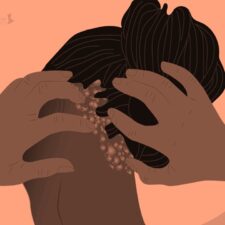
Sunny Hostin has been a co-host on The View since 2016, and currently works alongside Alyssa Farah Griffin, Whoopi Goldberg, Joy Behar, Sara Haines and Ana Navarro. The ladies share topics ranging from politics to celebrities, family life, and everything in between. Sometimes the conversations can get deep, heated, heartfelt, and revealing.
Recently, Hostin revealed that she ‘almost died’ after suffering a medical emergency during an episode of The View this week.
The TV personality, 56, opened up about the harrowing incident on the ABC talk show on Friday.
Hostin found herself in danger when guest Debbie Matenopoulos made an appearance to promote her new cookbook titled Greek.ish, and also brought along a few meals for the hosts to taste.
What Caused Her Severe Reaction?
At one point, Matenopoulos — who previously was a host on The View in the late ’90s — described the items she brought, such as an orzo dish. However, Hostin soon found out that she was deathly allergic to one of the ingredients.
“She has this wonderful food, Greek food. And I have a terrible allergy to walnuts. And as I’m eating the food, Alyssa [Griffin] asks, ‘Are those walnuts in here?’ And she says, “Yes.”‘
Sunny shared that she began ‘to panic immediately’ and penned a ‘death note’ to Griffin who was sitting directly next to her at the time.
While telling the story on Friday, Hostin then held up a blue card which had the words, ‘I am allergic to walnuts,’ scribbled on the back.
Sunny continued, ‘And she responds with, “Oh no!” And I’m looking at [executive producer] Brian [Teta] and he’s like, “Is everything okay?”‘
The star had simply responded, ‘No, it’s not,’ by silently shaking her head in his direction.
Hostin was able to make it to the end of the segment before receiving medical aid from doctors on the set.
‘But what was great was our Disney nurses, man, they are like superheroes. They came in — nurse Jen came in — with an EpiPen. She was testing me. I had Benadryl. I was scared.’
Griffin chimed in to explain that she couldn’t read the note that Sunny had quickly written down, but added, ‘We’re glad you made it through.’
The TV personality went on to explain that she hadn’t had an allergic reaction to that extent in a decade.
How Bad Can a Nut Allergy Get?
A nut allergy, including tree nuts and peanuts, can cause a range of symptoms, from mild to severe, including anaphylaxis, a potentially life-threatening reaction. If you suspect a nut allergy, consult with an allergist for proper diagnosis and management, which may include carrying an epinephrine auto-injector.
Causes
Peanut allergy occurs when the immune system flags peanut proteins as harmful. When exposed to peanuts, the immune system releases symptom-causing chemicals into the bloodstream. These chemicals cause an allergic reaction.
Direct and cross-contact with peanuts could cause a reaction:
- Direct contact. The most common cause of peanut allergy is eating peanuts or foods that contain peanuts.
- Cross-contact. This happens when peanuts get into a product by mistake. It often happens when food is exposed to peanuts during processing or handling.
- Inhalation. Breathing in dust or aerosols containing peanuts, such as peanut flour, may cause an allergic reaction.
Symptoms
An allergic response to peanuts usually occurs within minutes after exposure. Peanut allergy signs and symptoms can include:
- Skin reactions, such as hives, redness or swelling.
- Itching or tingling in or around the mouth and throat.
- Digestive problems, such as diarrhea, stomach cramps, nausea or vomiting.
- Tightening of the throat.
- Shortness of breath or wheezing.
- Runny nose.
Anaphylaxis: A life-threatening reaction
Peanut allergy is the most common cause of anaphylaxis due to food. This medical emergency requires treatment with an epinephrine autoinjector (EpiPen, Auvi-Q, others) and a trip to the emergency room. Epinephrine is also called adrenaline.
Anaphylaxis signs and symptoms can include:
- Constriction of airways.
- Swelling of the lips, tongue and throat that makes it hard to breathe.
- A severe drop in blood pressure, also known as shock.
- Rapid pulse.
- Dizziness, lightheadedness or loss of consciousness.
When to See a Doctor
Talk to your care team if you have had any signs or symptoms of peanut allergy. Seek emergency treatment if you have a severe reaction to peanuts.
Call, or have someone else call 911 or your local emergency number if you have any signs or symptoms of anaphylaxis such as:
- Severe dizziness.
- Severe trouble breathing.
- Loss of consciousness.
If You’re Having an Allergic Reaction, Here’s What to Do:
If experiencing an allergic reaction, the first step is to identify and avoid the allergen. For mild reactions, over-the-counter antihistamines and hydrocortisone cream can provide relief. Severe reactions require immediate medical attention, including potentially using an epinephrine auto-injector (like an EpiPen) and calling emergency services.
For Mild Reactions:
- Identify and Avoid the Allergen: Determine what triggered the reaction and avoid further exposure.
- Over-the-Counter Medications: Antihistamines like loratadine (Claritin) or cetirizine (Zyrtec) can help with symptoms like itching and hives.
- Topical Treatments: Hydrocortisone cream can relieve itching and inflammation.
- Cool Compresses: Apply cool, moist cloths to affected areas for relief.
For Severe Reactions (Anaphylaxis):
- Call 911 Immediately: Severe reactions require prompt medical attention.
- Epinephrine Auto-Injector: If the person has an epinephrine auto-injector (like an EpiPen) and is trained on its use, administer it immediately.
- Keep the Person Calm: Anxiety can worsen symptoms, so try to keep the person calm and reassure them.
- Positioning: Have the person lie flat with their feet elevated or on their side if vomiting.
- Monitor Breathing: Watch for signs of breathing difficulties, such as wheezing or throat tightness.
- CPR: If the person stops breathing, begin CPR (cardiopulmonary resuscitation).




